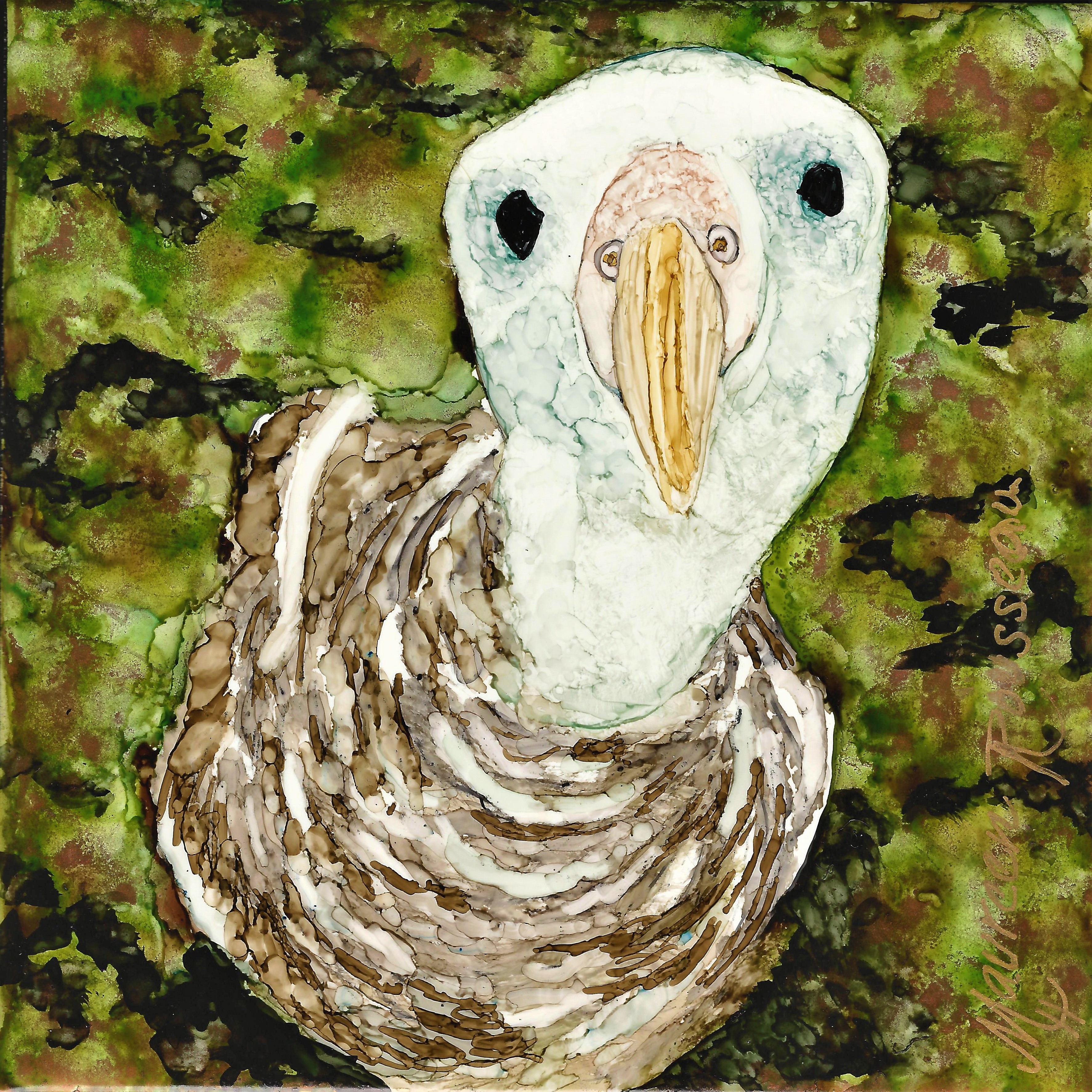
Tristan Albatross, artwork by Maureen Rousseau, from a photograph by Michelle Risi
The follows news item is taken in its entirety from BirdLife International’s website. It has been written by Oli Yates, Head of BirdLife’s Marine Programme.
“With a new protected area and a campaign to remove invasive mice, there have been many recent advances in the conservation of this Critically Endangered albatross. But our work isn’t over yet. Discover the measures in place to safeguard the species – and the gaps that still need to be filled.
The Tristan Albatross Diomedea dabbenena (Critically Endangered) is one of the great albatrosses, ranging widely across the South Atlantic and into the Indian Ocean. These birds feed on fish and squid in surface waters, returning to their nest sites every second year where eggs are laid in January, hatch in March-April and fledge eight to nine months later from around November.
Almost the entire global population of Tristan Albatross nest at Gough Island, an incredibly remote island in the middle of the South Atlantic – the most southerly of the Tristan da Cunha island group, on the very edge of the strong westerly winds known as the ‘roaring forties’. This UNESCO Natural World Heritage site is perfectly placed, if you’re an albatross, with year-round windy conditions, highly productive waters of the Tristan da Cunha Exclusive Economic Zone within immediate reach, and roughly equidistant between the continental shelves of South America and southern Africa.
The small community at Edinburgh of the Seven Seas, the settlement at Tristan da Cunha, have recently made a huge contribution to marine conservation by designating a Marine Conservation Zone across almost 700,000 km2 of their Exclusive Economic Zone. This ‘no-take zone’ excludes fishing in most areas, with low-impact sustainable fishing permitted around the islands and seamounts to ensure the islanders can maintain economic and food security. The people of Tristan da Cunha have given the world one the biggest sanctuaries for wildlife.
Gough Island would be the perfect habitat, but for the house mice which were accidentally introduced decades ago by visiting ships. Over time, the mice learned to exploit the young chicks of albatrosses and petrels, which have no natural defence against the mammalian threat. The mice are now estimated to account for the loss of over two million seabird eggs and chicks each year. This ghastly reality has ravaged the Tristan Albatross population, and now recent evidence shows the killer mice are able to devour the adult birds too. An incredible project is underway to eradicate these non-native mice from the island - one of the world's most challenging island restoration projects – which would restore the fortunes of the island's birds.
Increased protection for this Critically Endangered species is coming on in leaps and bounds at the breeding site and its surrounding waters. This improved protection is also reinforced by vital improvements in fishery management in the Benguela Current, where seabird deaths in the Namibian demersal longline fishery have been reduced by 98%, and in the South Africa hake trawl fishery by 90%. That equates to over 30,000 birds saved every year.
Despite these stunning advances, observers on Asian distant water tuna fishing vessels continue to report accidental ‘bycatch’ of Tristan Albatrosses in areas managed by the International Commission for the Conservation of Atlantic Tunas on the High Seas, outside the Tristan Marine Protected Zone.
The RSPB (BirdLife in the UK) runs a monitoring programme for Tristan Albatrosses on Gough Island. Fledgling and adult Tristan Albatrosses receive unique leg rings, so that the population can be monitored and understood over time. In the last year three rings from adult Tristan Albatrosses have been recovered by fisheries observers, indicating fishing vessels are likely not using the seabird bycatch prevention measures they are required to deploy. When used correctly, the mitigation measures (weighting the fishing lines, setting them at night and adding and brightly-coloured ‘bird-scaring lines’), are highly effective at reducing bycatch to negligible levels.
The around 95% of distant water fishing vessels do not carry observers. In order to enforce mandatory conservation measures, we need much stronger monitoring, a greater number of observers and the use of electronic monitoring technology. These remain key pieces of the puzzle to ensure the survival of these magnificent birds.”
With thanks to Jessica Law and Oli Yates.
John Cooper, ACAP Information Officer, 06 July 2021

 English
English  Français
Français  Español
Español